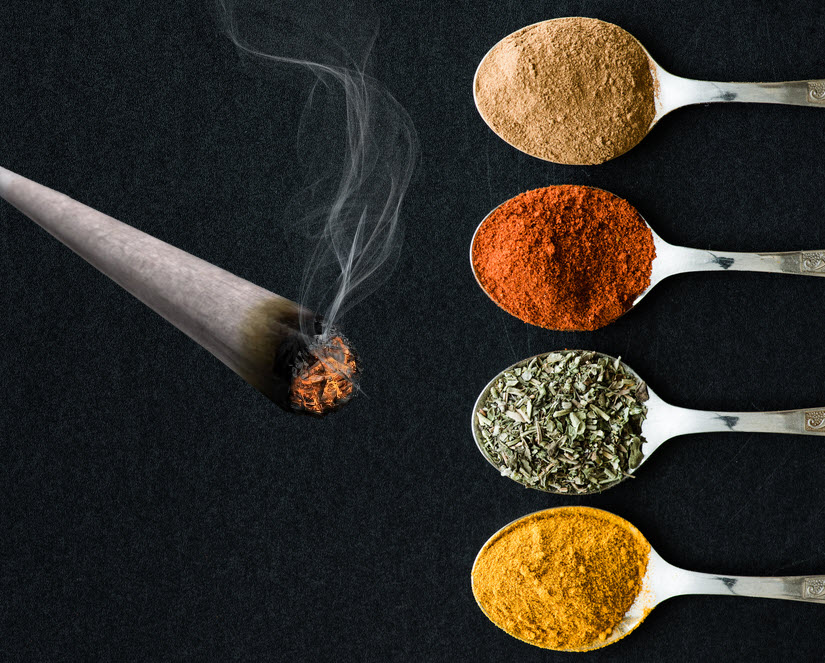
How to spice up your joint with herbal mixtures
When it comes to mixing things with cannabis, most people tend to choose other cannabis products; Hash, wax, kief, etc.
In Europe, it is common to use tobacco to cut grass due to its ridiculously high prices and some people have gotten used to it.
However, most people don’t think beyond these mixes when considering spicing up their joints.
That changes today!
Today we’re going to take a closer look at non-traditional herbal blends that you can add to your weed for a completely different physiological effect. We’re going to talk about a few different types of herbs and their traditional or medicinal uses.
Some of these techniques have been used to treat a wide variety of physical ailments for thousands of years, and best of all, most of them you can grow yourself!
If you are growing your own weed, you might consider adding these to your yard. That way, you can become a lot more versatile with your cannabis use.
The basis for making your own herbal mixtures
There are a few proportions to keep in mind when making your own herbal mixes.
-
The Basic Herb (40%) – Also known as the “Basic Herbs” The basic aspect of any herbal blend typically consists of a fluffy or thread-like herb that holds the rest of the herbs together.
-
Effect / taste notes (40%) – Next, let’s take a look at the “body” of the mixture. Between the basic mix and the action mix, you have roughly the same share. For example, the base could be regular old weed, while the action / flavor note could be kief or something similar.
-
Astringent Herbs (15%) – You want an astringent herb, that is, herbs that “dry out”. This is usually tobacco, but we’ll look at other herbs as well.
-
High Notes – The last 5% of the bowl is broken down into your “high notes” or “herbal accents”. These are your stronger herbs that affect the overall flavor profile and also have a modifying effect on the base herbs. (For example, put a blob on a bowl)
When we understand these dynamics, we can construct our own herbal mixes. Here is a quick snapshot of the situation:
-
Basic herb = 40%
-
Action herb = 40%
-
Astringent = 15%
-
High grades 5%
Mix up your herbs
When it comes to mixing, you should measure each herb carefully. Some people do it by weight, others just look at the amounts.
After measuring, remove the herbs from all seeds and stems and unwanted ingredients in the mixture. It’s best to do this by hand, but if the herbs aren’t too dirty, you can use a grinder.
When making a mixture for your pipe, you don’t have to worry too much about stems, but if you do remember to roll them – you definitely want to make them as fine as possible without turning them into powder.
It still has to be stringy herbs.
humidity
You don’t want to smoke herbs that are too dry. These burn too quickly, are hard on the throat and leave you in a coughing fit.
However, you don’t want to store your mixes with too much moisture either. So how do we solve this?
We store dry and then cure small batches for smoking as needed. As with weed, you should store it in an airtight glass jar that will be kept in a cool, dark place.
Another small jar is used to add moisture to your mixes. You can add anything like a small piece of apple, banana peel, lime / lemon peel, etc. to your mix. You will wait around 30 minutes to check the moisture of your mix. If it needs to sit a little longer, check every 30 minutes.
If you don’t want to affect the flavor profile of your herbs by adding peel or apples, you can take some cotton wool, soak it in water, and then squeeze out the excess water so it’s damp but not wet.
Again, follow the 30 minute rule to get the right humidity to smoke. You want them to be damp but still able to burn. This will also slow down the burning process.
A bunch of herbs to choose from:
BASE HERBS:
For basic herbs you can use; Mullein, raspberry leaf, pearly everlasting, damiana, mugwort, marshmallow root, willow bark
ACTION HERBS:
Yarrow, Pedicularis spp., Mint, lemon balm, wicker dogwood, green sage, goldenrod, chamomile, St. John’s wort, catnip, damiana, skullcap, lobelia, passion flower, red root leaf, tulsi, hops.
ACCENT HERBS (FOR THE KICK):
white sage, hummingbird sage, osha root or leaf, valerian, blue lotus, lime blossom and bracts, rose petals, eucalyptus, hyssop, lavender.
ATRINGING HERBS (to dry things up a bit)
uva-ursi / kinnikinnick, red root leaf, willow bark, raspberry leaf, green sage leaf, pipsissewa leaf, mugwort leaf, Palo Santo.
While this list provides you with herbs for making “non-cannabis” mixtures, cannabis in your particular mixture will be your “BASE HERBS” and could even contain parts of the EFFECTIVE HERBS.
But when you mix cannabis with other herbs, start experimenting with the overall effect.
Let’s look at some common mixes;
Common cannabis blends
Here are a few herbs that people have mixed with cannabis.
1 – Lavender – Add a little more coolness and flavor to your smoke
2 – Cannabis skullcap – skullcap has a mild calming effect when smoked, combine this with cannabis – you have a potential insomnia stopper in a class of its own!
3 – Cannabis Indica Mugwort – Many cultures smoked mugwort to induce vivid dreams. It also has some psychotropic effects when you are awake. If you want crazy dreams – dry a CannaWort joint.
4 – St. John’s wort – St. John’s wort is a very common medicinal herb and has a mood-stabilizing effect and can help with depression and melancholy. It can help reduce anxiety and can be used in larger quantities as a sedative. In combination with weed, it’s a powerful mix!
ADHESIVE UNDERLINE:
If you’re looking for a way to spice up your draws or grow some complementary smokable herbs, this article should have given you enough to start your cannablends journey!
HERB MIXTURES GO MAINSTREAM, READ MORE ..

YOU CAN BUY HERBAL SMOKE MIXES ONLINE NOW, SEE MEO!
OR..

WHAT IS A SPLIFF AND WHY WOULD YOU SMOKE POWER AND TOBACCO?

Post a comment: